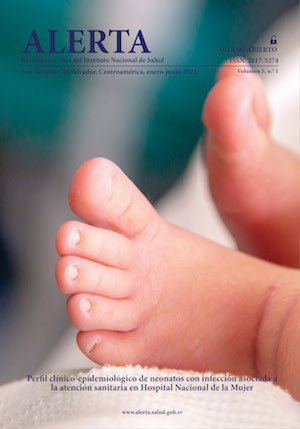The role of basic research against COVID-19
DOI:
https://doi.org/10.5377/alerta.v5i1.13216Abstract
Madam Editor:
Basic research is questioned for the contributions it generates, because many times there are no obvious results that can be applied for the benefit of society in the short term. However, it is a controversy that it is currently inadmissible to conceive of a society without science.
The experience of the SARSCoV-2 pandemic has reminded us of the essential role of new knowledge in assertive decision-making, both in individual daily life and in the decisions of those who make decisions. Now more than ever, knowledge obtains an incalculable value in society.
The response generated towards the COVID-19 pandemic arises from the scientific contribution enriched from centuries ago, from different fields of basic research. For example, it was in the area of virology, in 1892, where it was discovered that viruses are the cause of many diseases. Thus, in 1965 the first coronavirus was described. Also, thanks to basic research, in 1978, it was known that protein S is required to cause infection and is currently the target of many vaccines.
In the field of Immunology, in 1798, it was discovered that vaccines protect against diseases, but it was not until 1890 that it was identified that it is the antibodies that protect against infection. Research in fundamental sciences such as Cell Biology allowed it to be discovered in 1899 that cell membranes are made from lipids and form a barrier of molecules on the outside of the cell. This gave way to the identification in 1972 that lipid droplets can be used to transport material within the cell; knowledge that has been relevant to the transport of messenger RNA in vaccines against COVID-19.
There have been many contributions from Molecular Biology for the current fight against the pandemic. Since mRNA was discovered in 1961, scientists from 1966 can read the mRNA model for protein production1, the basis for the production of biological.
Thus, also, thanks to the theory of germs born from basic research by many scientists, aseptic and antiseptic techniques were imposed, one of the most effective and cheapest public health interventions such as the discovery in the 19th century of the benefit of washing of hands to prevent diseases2.
Basic research has been answering different questions: what?, how?, why?, to various mechanisms of life. Due to its purpose of analyzing how processes or concepts work, it has been providing contributions to the causality of diseases.
What appears to be a simple product is actually knowledge obtained in a non-linear way, where different areas have had to be related. As new knowledge emerges, it is taken up again to improve approaches and proposals on innovative possibilities that complement concepts and develop the knowledge of translational and clinical research. The first is responsible for collecting and applying the data and information obtained from basic research to carry out a "translation" for the search for potential therapies; the second collects the achievements of translational research and tests whether they are safe and effective in treating diseases in human clinical trials. This constant flow of new discoveries is synergistic in driving innovative research.
COVID-19 has appeared at a time when the scientific system is more sophisticated and with faster global responses than in the past. The Internet, the growing culture of open science, and the convergence of digital technologies and biotechnology have transformed this research landscape.
Facing a health crisis of the magnitude of the COVID-19 pandemic has required having scientific systems capable of developing rapid and effective detection tests (both in sensitivity and specificity), searching for effective therapies, developing vaccines and perfecting predictive algorithms of the disease. Evolution of the pandemic. This is not possible without knowledge of the biological mechanisms of similar viruses, which requires several years of basic research; also have the enabling conditions to investigate, such as access to reagents, equipment and specialized personnel, laboratories with adequate biosafety levels and large databases on mobility patterns and population characteristics3. Understanding how this disease works is essential in order to find a way to combat it.
mRNA vaccines against COVID-19 (such as those made by Moderna and PfizerBioNTech) are good examples of how basic research lays the groundwork for innovative technologies to improve human health. These vaccines are lipid droplets that deliver a set of instructions (the mRNA) to cells to train the body to fight coronavirus infection and, in human trials, have been shown to be highly protective against severe COVID-19. The ingredients of these vaccines are quite simple, but they could never have been made without the fundamental knowledge of molecular biology, virology, immunology, and cell biology that scientists have accumulated over centuries of basic scientific research1.
Given the experience that we are acquiring from the COVID-19 pandemic, as a country and within the Latin American region, it should serve to recognize the lessons that it leaves us, among them the importance of investing in the generation of greater scientific capacities, as well as on the intensity and the form that this effort should take.
Long-term financing must be redefined for the strengthening of scientific competencies, conditions for regional collaborative alliances, promoting proactive science and technology; At the same time, the availability and access to data is improved for the development of technological solutions and that contribute to decision-making based on objective support with a scientific basis.
Downloads
1508
Downloads
Published
How to Cite
Issue
Section
License
Copyright (c) 2022 Santa Romero Jovel

This work is licensed under a Creative Commons Attribution 4.0 International License.
Privacy statement:
Alerta articles are published under license Creative Commons 4.0 CC BY: https://creativecommons.org/licenses/by/4.0/
Authorship rights
Revista Alerta gives the authors exclusive control of their work and the right to be acknowledged and cited.





